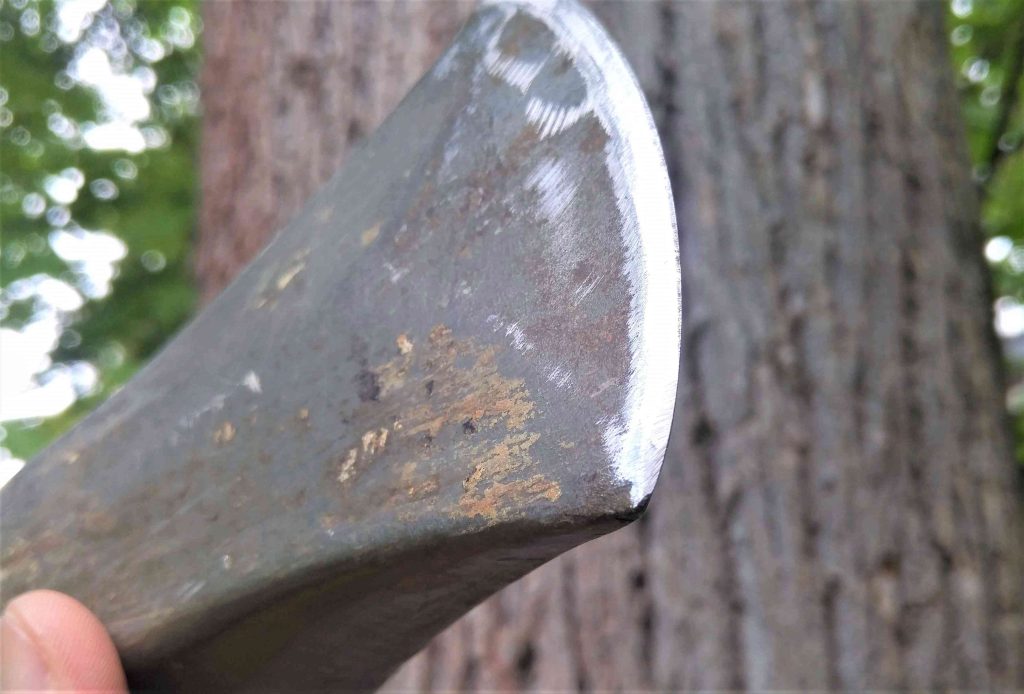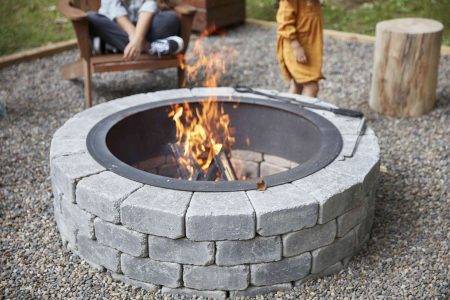There is no better tool than an axe for cutting or splitting small quantities of wood quickly, neatly, and economically. This ancient tool has maintained its relevance through the ages and today is still a reliable addition to workshops and campsites.
Axes are expected to do a lot of work and can become dull in just a few sessions. Hitting a rock, dense wood, wet wood, or even dirt can dull the axe. You can sharpen your axe at home if you have a grinder, a file, or a sharpening stone. If you’re caught in a bind, you can also use coarse-grit sandpaper to sharpen your axe blade; however, you won’t be able to re-profile the edge using sandpaper. The best angle for sharpening an axe is about 25 degrees; if you use a 20 to 30 degree-angle, that should be good.
In less than 15 minutes, you can use any of these methods and be up and running again, chopping wood.
Why It’s Important to Sharpen an Axe
Experienced cooks know that dull knives are more dangerous than sharp knives. That’s because more pressure has to be exerted on the knife to get it to work. With axes, much of the same theory applies.
When splitting a log with a sharp axe, you expect to raise it and then swing it down with a certain amount of force. As the axe dulls, you are forced to strike that wood with more force—until it’s more about a blunt force than a sharp edge cleaving the wood fibers.
When to Sharpen an Axe
Sharpen your axe before any wood-cutting session or at the beginning of fall or winter. Axe-sharpening should not be only an annual event. When cutting wood, frequently stop and run your finger along the axe’s edge to assess its sharpness. An axe should be sharp enough to slice through wood fibers but not razor-sharp so that you can shave with it.
If you are working too hard to chop the wood, this can physically take a toll on you. A good axe strike should be mostly propelled by gravity, with the weight of the axe head and its sharpness doing most of the work.
Safety Considerations
Sharpening an axe is dangerous in many ways. Always wear hearing and eye protection. When running the grinder, make sure that you know how to use the grinder and have carefully read the instructions that came with it.
Make sure that you have no loose clothing, hair, or jewelry near the grinder. Wear a long-sleeved shirt, pants, and shoes. Before you touch the grinder to the edge of the axe, ensure that you will not be in the direction of the hot metal filings. Wear gloves when hand-filing the axe. After sharpening the axe, be careful about running your finger on the edge.
What You’ll Need
Equipment / Tools
All Methods
- Bench vise
- Heavy leather gloves
- Eye protection
- Hearing protection
Grinder Method
- Hand grinder
File Method
- Bastard file (metal file)
Sharpening Stone Method
- Coarse whetstone (250-3,000 grit)
- Fine whetstone (3,000-8,000 grit)
- Cleaning brush
Materials
- Axe
- Mineral oil or honing oil
Instructions
How to Sharpen an Axe With a Grinder
Power tools will get the job of sharpening your axe done the quickest. A grinder has an abrasive wheel or a disc that rotates with the help of a powered motor. However, they can be imprecise since they’re all power and have no finesse.
-
Check for Indicators of a Dull Axe
Unlike a dull knife, a dull axe can be less noticeable. When cutting wood, so much force is applied that even a dull axe will cut reasonably well. Taking a visual check of the dull axe’s edge, it looks rounded and humped. Run your fingers over the edge of a dull axe and it will be smooth. Rust sometimes accompanies a dull axe; but sharp axes, too, can become rusted if not properly maintained.
-
Secure the Axe for Sharpening
If you have a bench vise that allows access to the axe on both sides, this is the most secure way to hold an axe for sharpening. If not, improvise a vise with available materials. Two bricks on either side of the axe head, each held down by a carpenter’s clamp, is one way to hold an axe upright.
-
Apply Honing Oil to the Axe
Use a cotton rag to apply a honing oil such as mineral oil to the cutting edge of the axe. Light oils like mineral oil are preferable to thicker petroleum-based oils because they will not slow down or interfere with the sharpening process. Not only that but mineral oils will not go bad over time.
-
Sharpen the Bevel
Turn on the angle grinder. Begin by grinding about 1/2-inch down from the edge. An axe edge will be a smooth bevel that ends in a sharp point. Repeat on the other side.
-
Sharpen the Edge of the Axe
Move the grinder to the edge of the axe. Change the angle of the grinder to about 25 degrees. When finished with one side, move to the other side.
-
Inspect the Sharpened Axe
The edge of the sharpened axe should feel at least as sharp as the folded side of a piece of paper that has been folded over once. Sharper is always preferable. There should be no nicks or gouges on the cutting surface. If so, apply the grinder to the axe until the nicks and gouges have been smoothed out.
How to Sharpen an Axe With a File
A file is a handy tool for shaping the edge and profile of the axe blade. The best choice is a bastard mill file made for sharpening blades. Use one that is between 8 and 12 inches long.
-
Hand-File the Axe Edge
Working from above, hand-file the axe edge with the bastard file. File downward.
Warning
Be sure to wear heavy leather gloves when hand-filing the axe.
-
Maintain the File Edge
Tilt the file downward toward the axe’s edge to raise a sharper edge. Keep going back and forth between each side until the axe is sharpened to your satisfaction.
How to Sharpen an Axe With a Sharpening Stone
Sharpening stones have been used to sharpen tools since the Stone Age. A sharpening stone is also called a whetstone. To “whet,” in this case, means to sharpen. Use a whetstone when you want the sharpest tip.
-
Select a Whetstone
A whetstone comes in different grades of coarseness. Most sharpening stones are dual-sided, with a coarser grain on one side and a finer grain for finishing. Many whetstones require using lubricating oil on the stone and axe while sharpening. However, a popular type of sharpening stone, waterstone, only requires water.
A coarse grit stone is best for chipped or dull axes (250- to 3,000-grit). A 4,000 to 8,000-grit stone is best used on moderately sharp axes that only need finishing.
-
Coat Your Axe Edge With Oil or Water
If you use waterstone as your whetstone, coat your axe edge and stone with water. For all other types of sharpening stones, coat your edge and stone with honing oil or mineral oil.
-
Sharpen the Axe Head With the Coarser Stone
Start by using the rough side of the stone, using a circular motion across the edge on one side. Stay at a consistent angle, roughly 25 degrees. Mirror exactly what you did on both sides, giving each side the same time and attention. Remove nicks and dents as you are grinding.
Finish the edge by using a finer grit stone. Finer grit stones sharpen the tip.
-
Will a knife sharpener work on an axe?
Some knife sharpeners can work on axes, but not those with a fixed angle. The angle used to sharpen knives is not good to use on axes. If you use a knife whetstone, it would be appropriate to use it for an axe too.
-
Should an axe be razor-sharp?
An axe should not be razor-sharp. You want an axe to be sharp enough, to make clean cuts without exerting more power. The problem with a razor-sharp blade is it’s razor-thin. Instead, opt for a thicker, sturdier tip, less prone to nicks; it can stand up better to repetitive force.
-
How long should my axe handle be?
The two standard sizes are full-sized at 36 inches and a boy’s axe which is 28 inches—the shorter, the better for delivering more force. Most recommend using a 28- to 31-inch handle for better handling for full-grown, 6-foot adults; 36 inches tends to be more unwieldy.
-
How much does it cost to get an axe sharpened professionally?
Depending on your area, it may cost between $12 and $25 to get an axe sharpened professionally. Even if you are adept at sharpening your own axe, it may be worth it to have the axe sharpened by a pro every so often.
-
Do you sharpen both sides of an axe?
Yes, you should sharpen both sides of an axe. Both sides need to be balanced out with the same attention given to each side, 50-50 balance.
Read the full article here














